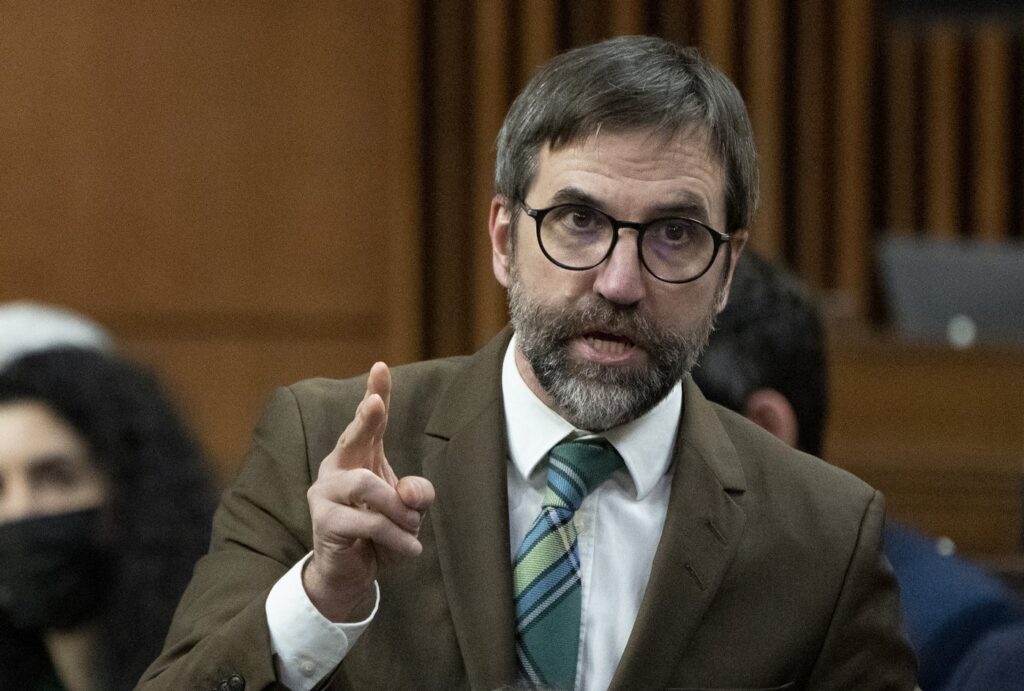
Minister of Environment and Climate Change Steven Guilbeault rises during Question Period, in Ottawa, Thursday, Feb. 17, 2022. Ottawa said in a press release that Guilbeault has been granted another 40 days to review the “extensive information” about whether the proposed Bay du Nord project will have significant environmental impacts. THE CANADIAN PRESS/Adrian Wyld
OTTAWA — Canada has had at least 11 different climate plans and nine emissions targets since 1988. Here’s a snapshot of some of them.
1988: Canada hosts a conference in Toronto called Changing Atmosphere: Implications for Global Security, where governments and NGOs agree that human behaviour is affecting the atmosphere. Prime Minister Brian Mulroney gives the opening address, and by the end of the event, parties agree to strive to cut greenhouse gas emissions to 20 per cent below 1988 levels by 2005.
1990: The Mulroney government releases the Green Plan, which includes $175 million for about two dozen new policies on greenhouse gas emissions, including investments in energy efficiency, alternative energy and tree planting. It sets a goal to “stabilize” emissions at 1990 levels by 2000.
1992: Canada signs the United Nations Framework Convention on Climate Change in Rio de Janeiro, which sets up the next three decades of global conferences to address greenhouse gas emissions.
1993: In the federal election, Liberal Leader Jean Chrétien promises to cut emissions to 80 per cent of what they were in 1988 by 2005, the same target Mulroney agreed to in 1988.
1995: Chretien’s government introduces the National Action Program on Climate Change, promising to cut 66 million tonnes of emissions from current levels in 15 years. The plan includes more than 400 possible projects or programs, such as retrofitting federal buildings, updating the national building code to identify thermal efficiencies and convincing industry to voluntarily submit climate plans.
1997: Canada agrees to the Kyoto Protocol, an extension of the UN climate framework. It sets a new target to cut emissions to six per cent below 1990 levels by 2012.
1998: The federal government introduces its new Action Plan 2000 on Climate Change to work toward its Kyoto target, with a $500-million investment over five years. It includes goals to improve vehicle fuel efficiency, investments in renewable energy and a promise to look further at using carbon capture and storage technology in the oil and gas sector.
2002: Climate Change Plan for Canada, another pathway toward the Kyoto target, talks about emissions credits trading, increased use of ethanol and biodiesel, investments in public transit and aiming to retrofit one-fifth of commercial and institutional buildings by 2010.
2005: Project Green: A Plan for Honouring our Kyoto Commitment followed the 2005 federal budget, which included more than $3 billion in climate investments, including funds to encourage wind power and other renewable energy options and tax incentives for efficient energy generation. The latest plan encourages the development of a domestic emissions credit trading system, and promises to regulate emissions from certain industries.
2007: Conservative Prime Minister Stephen Harper, a year after saying Canada wouldn’t be able to meet the Kyoto target, sets a new goal to cut emissions to 20 per cent below 2006 levels by 2020. It’s the first to base its action mostly on cutting emissions intensity — the amount of greenhouse gas produced per unit of production, such as per barrel of oil, or tonne of steel.
2009: Canada signs the Copenhagen Accord, a new global climate plan under which Canada promises to cut emissions 17 per cent below 2005 levels by 2020.
2011: Canada formally withdraws from the Kyoto Protocol.
2015: Environment Minister Leona Aglukkaq submits a new national emissions target ahead of a major UN climate conference in Paris. The new target, 30 per cent below 2005 levels by 2030, comes with promises to cut methane emissions in the oil and gas sector, and regulations for natural gas power plants and fertilizer production.
In November, just weeks after Prime Minister Justin Trudeau and the Liberals win the election and take office, Canada signs the Paris agreement at that UN conference, using the same Conservative targets.
2016: Trudeau surprises and angers some premiers with a sudden plan to impose a minimum price on pollution on provinces without their own similar plan. Shortly after, most provinces sign on the Pan-Canadian Framework for Clean Growth and Climate Change, which shows a path of policies to get Canada much of the way to the Paris target. They include the carbon price, as well as better building codes, eliminating coal power and a clean fuel standard to reduce emissions generated by burning fuels.
2020: Environment Minister Jonathan Wilkinson introduces a “strengthened” climate plan aiming to introduce more measures to try and meet the original 2030 target and start working toward net-zero emissions by 2050. A Healthy Environment and a Healthy Economy promises to keep increasing the carbon price until it reaches $170 a tonne in 2030, and to invest in clean technology and a national clean electricity grid.
2021: Canada submits updated emissions targets to the UN, now aiming for 40 to 45 per cent below 2005 levels by 2030. It also passes the Canadian Net-Zero Emissions Accountability Act, which enshrines the targets into law for the first time, and requires regular reporting and reviews of progress.
2022: Environment Minister Steven Guilbeault introduces the Emissions Reduction Plan, showing the path to getting to the new 2030 targets.
This report by The Canadian Press was first published March 29, 2022.
The Canadian Press
- 0098 SASPO-2874_Self Serve Campaign_New Connects_Youtube_v30098 SASPO-2874_Self Serve Campaign_New Connects_Youtube_v3
- 0100 Turnbull Project Manager0100 Turnbull Project Manager
- 0099 Mryglod Steel 1080p0099 Mryglod Steel 1080p
- 0097 Eagle Sky Ventures LTD0097 Eagle Sky Ventures LTD
- 0095 Fast Trucking nearly 70 years good at it0095 Fast Trucking nearly 70 years good at it
- 0053 Kingston Midstream Westspur Alameda Click Before You Dig0053 Kingston Midstream Westspur Alameda Click Before You Dig
- 0092 Turnbull projects big and small0092 Turnbull projects big and small
- 0046 City of Estevan This is Estevan Teaser0046 City of Estevan This is Estevan Teaser
- 0087 Lori Carr Coal Expansion0087 Lori Carr Coal Expansion
- 0077 Caprice Resources Stand Up For Free Speech0077 Caprice Resources Stand Up For Free Speech
- 0076 Latus only0076 Latus only
- 0061 SIMSA 2024 For Sask Buy Sask0061 SIMSA 2024 For Sask Buy Sask
- 0055 Smart Power Be Smart with your Power office0055 Smart Power Be Smart with your Power office
- 0051 JML Hiring Pumpjack assembly0051 JML Hiring Pumpjack assembly
- 0049 Scotsburn Dental soft guitar0049 Scotsburn Dental soft guitar
- 0041 DEEP Since 2018 now we are going to build0041 DEEP Since 2018 now we are going to build
- 0032 IWS Summer hiring rock trailer music
- 0022 Grimes winter hiring
- 0021 OSY Rentals S8 Promo
- 0018 IWS Hiring Royal Summer
- 0013 Panther Drilling PO ad 03 top drive rigs
- 0006 JK Junior
- 0002 gilliss casing services0002 gilliss casing services
- 9002 Pipeline Online 30 sec EBEX9002 Pipeline Online 30 sec EBEX
- 9001
